Thyrea girardii (Durieu & Mont.) Bagl. & Carestia
Atti Soc. Critt. Ital., 2: 349, 1881. Basionym: Collema girardii Durieu & Mont. in Durieu - Flore Algérie Crypt., 1: 1999, 1846-1849.
Synonyms: Omphalaria helvelloidea (Schaer.) A. Massal.
Distribution: N - VG (TSB 5706), Frl, Ven, Lomb, Piem (Isocrono & al. 2004), Lig. S - Cal (Puntillo 1996).
Description: Thallus squamulose-umbilicate to subfoliose-umbilicate, monophyllous, gelatinous when wet, forming lobulate, smooth or minutely verrucose, densely blue-grey pruinose, up to 2.5 cm wide rosettes. Marginal lobules rounded at apex, usually horizontal, rarely suberect. Thallus almost heteromerous, 300-500 µm thick, the medulla well-developed, 100-200 µm thick, composed of hyphae with prismatic, 2-3 µm wide cells, arranged in a lax network, with only a few photobiont cells in the peripheral parts; outer layer 100-150 µm thick, densely packed by the photobiont, the hyphae mainly anticlinally oriented. Apothecia immersed or semi-immersed, hemiangiocarpic, forming pycnoascocarps from ascogonia beneath pycnidia, laminal, rarely marginal, 0.2-0.7 mm across, with a brown, concave, initially punctiform disc and a grey-pruinose, thin and hardly prominent margin. Proper exciple cupular, 15-25 µm wide, consisting of strongly coherent hyphae; epithecium pale brown, 5-7 µm thick; hymenium colourless, 100-130 µm thick, separated into partial hymenia by intrusions of wedge-shaped, sterile thalline tissue, covered by a continuous layer of sterile tissue separated by the pore-like discs of the partial hymenia, I+ blue turning wine-red; paraphyses 2-3 µm thick, septate and constricted at septa, simple or sparingly branched, not anastomosing; hypothecium colourless, 40-65 µm thick. Asci 8-spored, cylindrical with a I+ blue cap. Ascospores 1-celled, hyaline, globose or broadly ellipsoid, 10-15 x 7.5-10 µm. Pycnidia globose, unilocular, 100-130 µm across. Conidia 1-celled, ellipsoid, 2-3 x 1.5-2 µm. Photobiont cyanobacterial, chroococcoid, with a few cells measuring 8-16 x 4-8 µm, surrounded by a brownish gelatinous sheath. Spot tests: all negative. Chemistry: without lichen substances.
Note: a Mediterranean to mild-temperate species found on calcareous rocks; ecology and distribution resemble those of T. confusa.
Growth form: Foliose, umbilicate
Substrata: rocks
Photobiont: cyanobacteria, coccaceous (e.g. Gloeocapsa)
Reproductive strategy: mainly asexual, by isidia, or isidia-like structures (e.g. schizidia)
On otherwise dry surfaces with short periods of water seepage after rain
Commonnes-rarity: (info)
Alpine belt: absent
Subalpine belt: absent
Oromediterranean belt: absent
Montane belt: absent
Submediterranean belt: rare
Padanian area: absent
Humid submediterranean belt: rare
Humid mediterranean belt: rather rare
Dry mediterranean belt: very rare
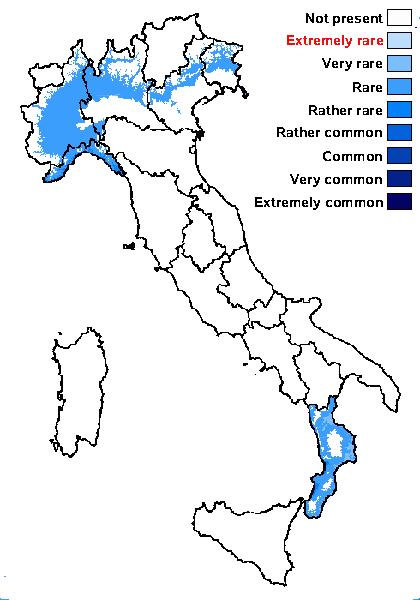
Predictive model
Herbarium samples
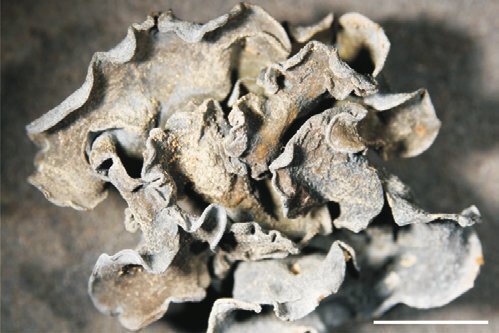
Matthia Schultz - Source: New and Additional Records of Cyanolichens from Turkey November 2015Herzogia 28(2):359-369
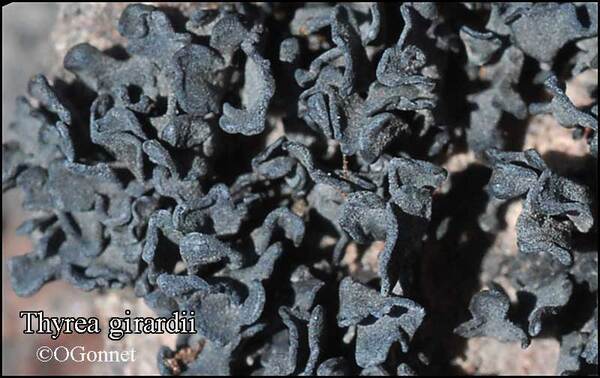
Courtesy Danièle et Olivier Gonnet - Source: hhttps://www.afl-lichenologie.fr/Photos_AFL/Photos_AFL_T/Thyrea_girardii.htm
France, session AFL 2010 - Hérault

Courtesy Danièle et Olivier Gonnet - Source: hhttps://www.afl-lichenologie.fr/Photos_AFL/Photos_AFL_T/Thyrea_girardii.htm
France, session AFL 2010 - Hérault
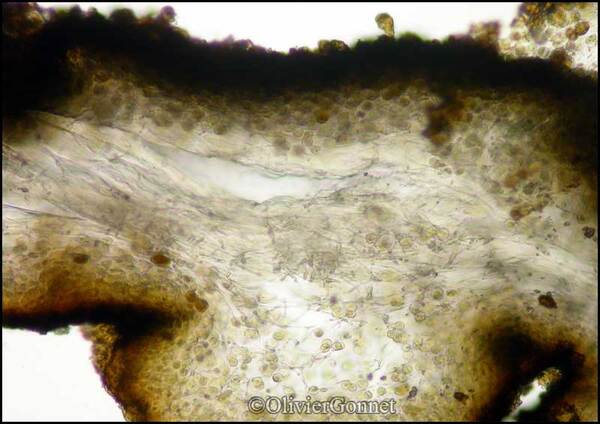
Courtesy Danièle et Olivier Gonnet - Source: hhttps://www.afl-lichenologie.fr/Photos_AFL/Photos_AFL_T/Thyrea_girardii.htm
France, session AFL 2010 - Hérault

Courtesy Danièle et Olivier Gonnet - Source: hhttps://www.afl-lichenologie.fr/Photos_AFL/Photos_AFL_T/Thyrea_girardii.htm
France, session AFL 2010 - Hérault
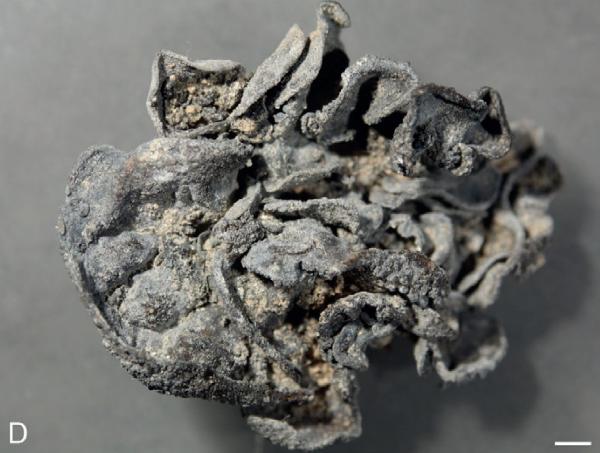
Source: Prieto M., Wedin M., Schultz M. 2024. Phylogeny, evolution and a re-classification of the Lichinomycetes. Studies in Mycology, 109: 595-655. - CC BY-NC-ND
Thyrea girardii, foliose, divided into few broadly rounded,
conspicuously bluish grey pruinose lobes (Urbanavichus 0905071a). Scale bar: 1 mm.
Growth form: Foliose, umbilicate
Substrata: rocks
Photobiont: cyanobacteria, coccaceous (e.g. Gloeocapsa)
Reproductive strategy: mainly asexual, by isidia, or isidia-like structures (e.g. schizidia)
On otherwise dry surfaces with short periods of water seepage after rain
Commonnes-rarity: (info)
Alpine belt: absent
Subalpine belt: absent
Oromediterranean belt: absent
Montane belt: absent
Submediterranean belt: rare
Padanian area: absent
Humid submediterranean belt: rare
Humid mediterranean belt: rather rare
Dry mediterranean belt: very rare

Predictive model
| Herbarium samples |

Matthia Schultz - Source: New and Additional Records of Cyanolichens from Turkey November 2015Herzogia 28(2):359-369

Courtesy Danièle et Olivier Gonnet - Source: hhttps://www.afl-lichenologie.fr/Photos_AFL/Photos_AFL_T/Thyrea_girardii.htm
France, session AFL 2010 - Hérault

Courtesy Danièle et Olivier Gonnet - Source: hhttps://www.afl-lichenologie.fr/Photos_AFL/Photos_AFL_T/Thyrea_girardii.htm
France, session AFL 2010 - Hérault

Courtesy Danièle et Olivier Gonnet - Source: hhttps://www.afl-lichenologie.fr/Photos_AFL/Photos_AFL_T/Thyrea_girardii.htm
France, session AFL 2010 - Hérault

Courtesy Danièle et Olivier Gonnet - Source: hhttps://www.afl-lichenologie.fr/Photos_AFL/Photos_AFL_T/Thyrea_girardii.htm
France, session AFL 2010 - Hérault

 INDEX FUNGORUM
INDEX FUNGORUM
 GBIF
GBIF
 DOLICHENS
DOLICHENS

